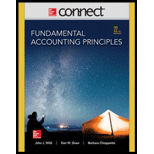
Concept explainers
Concept Introduction:
Periodic Inventory System: The periodic inventory system records and updates the inventory at the end of a particular period. The inventory balance is not updated after each transaction and it is updated periodically.
Methods of
• Specific identification method: Under this method the cost of goods sold and ending inventory units are identifiable and the cost is calculated accurately for each unit sold and in the inventory.
• Weighted Average method: Under this method, the cost per unit of the inventory is calculated as weighted average cost per unit and the cost of goods sold and inventory is calculated with the help of weighted average cost per unit.
• FIFO method: FIFO Stands for First In First Out. Under this method, the units purchased first are assumed to be sold first and cost of goods sold is calculated accordingly. The ending inventory in the method includes the latest units purchased.
• LIFO method: LIFO Stands for Last In First Out. Under this method, the latest units purchased are assumed to be sold first and cost of goods sold is calculated accordingly. The ending inventory in the method includes the oldest units purchased.
Requirement (a):
To determine: Cost of ending inventory and Cost of goods sold using the Specific identification method.
Requirement (b):
To determine: Cost of ending inventory and Cost of goods sold using the periodic inventory weighted average method.
Requirement (c):
To determine: Cost of ending inventory and Cost of goods sold using the periodic inventory FIFO method.
Requirement (d):
To determine: Cost of ending inventory and Cost of goods sold using the periodic inventory LIFO method.
Requirement:
To identify: The method that yields lowest net income
Want to see the full answer?
Check out a sample textbook solution
Chapter 6 Solutions
FUND.ACCT.PRIN -ONLINE ONLY >I<
- Elmont Industries issues $2,400,000 of 8% bonds at 101. What is the amount of cash Elmont would receive from the sale? A. $2,373,000 B. $2,240,000 C.$2,424,000 D. $2,185,000 E. None of the above. Help mearrow_forwardPlease explain how to solve this financial accounting question with valid financial principles.arrow_forwardCan you help me solve this general accounting problem with the correct methodology?arrow_forward
- I am looking for a step-by-step explanation of this financial accounting problem with correct standards.arrow_forwardTyson manufacturing company produces and sells 120,000 units of a single product. Variable costs total $340,000 and fixed costs total $480,000. If each unit is sold for $12, what markup percentage is the company using?arrow_forwardI am searching for the correct answer to this general accounting problem with proper accounting rules.arrow_forward
- Need helparrow_forwardI am looking for the correct answer to this general accounting problem using valid accounting standards.arrow_forwardA company paid $36,000 for a 3-year insurance policy on January 1, 2024. The payment was recorded as a prepaid expense. What is the adjusting entry required on December 31, 2024?arrow_forward

 AccountingAccountingISBN:9781337272094Author:WARREN, Carl S., Reeve, James M., Duchac, Jonathan E.Publisher:Cengage Learning,
AccountingAccountingISBN:9781337272094Author:WARREN, Carl S., Reeve, James M., Duchac, Jonathan E.Publisher:Cengage Learning, Accounting Information SystemsAccountingISBN:9781337619202Author:Hall, James A.Publisher:Cengage Learning,
Accounting Information SystemsAccountingISBN:9781337619202Author:Hall, James A.Publisher:Cengage Learning, Horngren's Cost Accounting: A Managerial Emphasis...AccountingISBN:9780134475585Author:Srikant M. Datar, Madhav V. RajanPublisher:PEARSON
Horngren's Cost Accounting: A Managerial Emphasis...AccountingISBN:9780134475585Author:Srikant M. Datar, Madhav V. RajanPublisher:PEARSON Intermediate AccountingAccountingISBN:9781259722660Author:J. David Spiceland, Mark W. Nelson, Wayne M ThomasPublisher:McGraw-Hill Education
Intermediate AccountingAccountingISBN:9781259722660Author:J. David Spiceland, Mark W. Nelson, Wayne M ThomasPublisher:McGraw-Hill Education Financial and Managerial AccountingAccountingISBN:9781259726705Author:John J Wild, Ken W. Shaw, Barbara Chiappetta Fundamental Accounting PrinciplesPublisher:McGraw-Hill Education
Financial and Managerial AccountingAccountingISBN:9781259726705Author:John J Wild, Ken W. Shaw, Barbara Chiappetta Fundamental Accounting PrinciplesPublisher:McGraw-Hill Education





